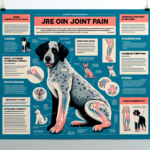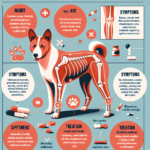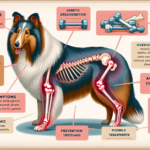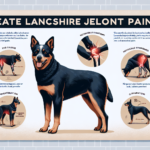Lagotto Romagnolo Joint Pain: Causes, Symptoms, Prevention, and Treatment

Introduction
The Lagotto Romagnolo is a unique and fascinating breed known for its curly coat and exceptional truffle-hunting abilities. Originating from the Romagna region of Italy, this breed has a rich history dating back to ancient times. Initially used as a water retriever, the Lagotto Romagnolo has evolved into a versatile working dog, excelling in various roles, including truffle hunting and companionship. With a friendly and affectionate temperament, this breed is a favorite among dog enthusiasts.
Like all breeds, the Lagotto Romagnolo is prone to certain health issues. While generally healthy, they can suffer from specific conditions, including joint pain. Joint health is particularly crucial for this breed due to their active lifestyle and working roles. Ensuring the well-being of their joints can significantly impact their quality of life and longevity.
Breed-Specific Joint Pain Risks
Genetic Predisposition
The Lagotto Romagnolo, like many purebred dogs, has a genetic predisposition to certain joint-related issues. Hip dysplasia, a condition where the hip joint doesn’t fit properly into the hip socket, is relatively common in this breed. Elbow dysplasia, another genetic condition affecting the elbow joint, can also occur. Both conditions can lead to arthritis and chronic pain if not managed properly.
Age-Related Risks
As the Lagotto Romagnolo ages, the risk of developing joint pain increases. While young dogs may show no signs of joint issues, symptoms can become more apparent as they reach middle age. Typically, owners should start monitoring for joint pain symptoms when their dog is around five to seven years old, although this can vary depending on the individual dog.
Activity Level and Joint Stress
The Lagotto Romagnolo is an active and energetic breed, often engaged in activities like truffle hunting, agility, and obedience training. While regular exercise is essential for their overall health, excessive or high-impact activities can put stress on their joints. Owners should be mindful of balancing activity levels to prevent overexertion and joint strain.
Common Symptoms of Joint Pain in Lagotto Romagnolo
General Symptoms
- Limping or favoring one leg
- Stiffness, especially after rest or sleep
- Reluctance to jump, run, or climb stairs
- Decreased activity or playfulness
- Swelling around the joints
- Visible discomfort or pain when touched
Breed-Specific Symptoms
In the Lagotto Romagnolo, joint pain may manifest in specific ways due to their unique build and activity patterns. Owners might notice a reluctance to engage in activities they previously enjoyed, such as truffle hunting or agility exercises. Additionally, the breed’s curly coat can sometimes obscure swelling or changes in gait, making it essential for owners to be vigilant in observing subtle changes in behavior and movement.
When to Consult a Vet
If you notice any of the above symptoms in your Lagotto Romagnolo, it’s crucial to consult a veterinarian promptly. Early diagnosis and intervention can significantly improve the prognosis and quality of life for dogs with joint pain. Regular veterinary check-ups are also essential for monitoring joint health and catching any issues early.
Preventive Measures for Joint Health
Exercise Recommendations
Regular, moderate exercise is vital for maintaining joint health in the Lagotto Romagnolo. Activities like swimming, walking, and controlled play can help keep their joints flexible and muscles strong without causing excessive strain. Avoid high-impact activities like jumping or running on hard surfaces, which can exacerbate joint issues.
Dietary Suggestions
A balanced diet rich in essential nutrients can support joint health. Consider incorporating foods or supplements that contain glucosamine, chondroitin, and omega-3 fatty acids, which are known to promote joint health and reduce inflammation. Consult your veterinarian for specific dietary recommendations tailored to your dog’s needs.
Weight Management
Maintaining a healthy weight is crucial for reducing joint stress in the Lagotto Romagnolo. Excess weight can exacerbate joint pain and lead to other health issues. Monitor your dog’s weight regularly and adjust their diet and exercise routine as needed to keep them at an optimal weight.
Early Screening and Monitoring
Early screening for joint issues can help catch problems before they become severe. Regular veterinary check-ups, including X-rays and physical examinations, can identify early signs of joint dysplasia or arthritis. Genetic testing can also provide insights into your dog’s predisposition to joint issues, allowing for proactive management.
Treatment Options for Joint Pain
Non-Surgical Treatments
Non-surgical treatments for joint pain in the Lagotto Romagnolo include medications, physical therapy, and lifestyle adjustments. Anti-inflammatory medications and pain relievers can help manage symptoms, while physical therapy can improve joint function and mobility. Lifestyle adjustments, such as providing a comfortable bed and avoiding high-impact activities, can also alleviate joint pain.
Surgical Options
In severe cases, surgical intervention may be necessary to address joint pain. Common surgical options include hip replacement, arthroscopy, and joint fusion. These procedures can significantly improve the quality of life for dogs with advanced joint issues. Consult your veterinarian to determine the best course of action for your dog.
Alternative Therapies
Alternative therapies like acupuncture, hydrotherapy, and massage can provide additional relief for dogs with joint pain. Acupuncture can help reduce pain and inflammation, while hydrotherapy offers low-impact exercise that supports joint health. Massage can improve circulation and reduce muscle tension, providing comfort for dogs with joint pain.
Lifestyle and Management Tips
Daily Care Routine
A consistent daily care routine can help manage and alleviate joint pain in the Lagotto Romagnolo. This routine might include gentle exercise, a balanced diet, and regular veterinary check-ups. Providing a comfortable resting area and using supportive bedding can also make a significant difference in their comfort levels.
Modifying the Home Environment
Making adjustments to your home environment can help accommodate a dog with joint pain. Consider installing ramps to help them navigate stairs or get onto furniture. Orthopedic beds can provide additional support and comfort, while non-slip mats can prevent accidents on slippery surfaces.
Long-Term Management
Long-term management of joint pain involves a combination of regular veterinary care, appropriate exercise, and a balanced diet. Monitoring your dog’s weight and adjusting their activity levels as needed can help maintain their joint health. Consistent use of supplements and medications, as prescribed by your veterinarian, can also support long-term joint health.
FAQs About Lagotto Romagnolo and Joint Pain
What are the early signs of joint pain in Lagotto Romagnolo?
Early signs of joint pain include limping, stiffness, reluctance to move, and decreased activity levels. If you notice any of these symptoms, consult your veterinarian for a thorough examination.
Can joint pain in Lagotto Romagnolo be prevented?
While genetic predispositions cannot be entirely prevented, maintaining a healthy weight, providing appropriate exercise, and regular veterinary check-ups can help manage and reduce the risk of joint pain.
Are there specific exercises that are better for Lagotto Romagnolo with joint pain?
Low-impact exercises like swimming and walking are ideal for dogs with joint pain. These activities help maintain joint flexibility and muscle strength without causing excessive strain.
What dietary supplements are recommended for joint health in Lagotto Romagnolo?
Supplements containing glucosamine, chondroitin, and omega-3 fatty acids are beneficial for joint health. Consult your veterinarian for specific recommendations tailored to your dog’s needs.
When should I consider surgery for my Lagotto Romagnolo’s joint pain?
Surgery is typically considered when non-surgical treatments are no longer effective, and the dog’s quality of life is significantly impacted. Your veterinarian can help determine the best course of action based on your dog’s condition.
Conclusion
Joint health is a critical aspect of caring for a Lagotto Romagnolo. By understanding the breed-specific risks, recognizing early symptoms, and implementing preventive measures, owners can help ensure their dogs lead active and comfortable lives. Regular veterinary care, appropriate exercise, a balanced diet, and weight management are essential components of maintaining joint health. If joint pain does occur, a combination of non-surgical treatments, surgical options, and alternative therapies can provide relief and improve the quality of life for your Lagotto Romagnolo. Always consult your veterinarian for personalized advice and treatment plans to keep your dog healthy and happy.




